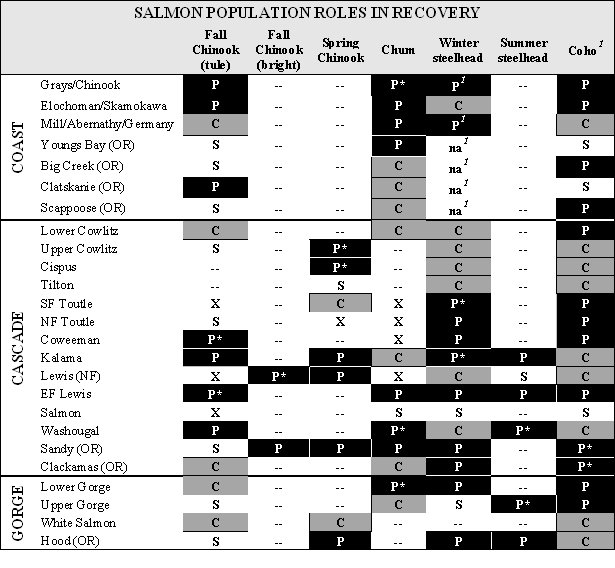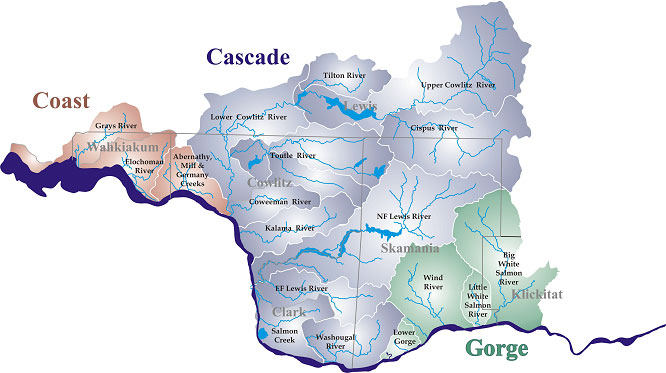US
AND ISP
| ABOUT US |
MONITORING |
PUBLICATIONS |
REGIONS |
SCIENCE AND ISP |
Transmittal LetterGovernor Gary Locke; Jeff Koenings, Director of Washington Department of Fish and Wildlife; and Bill Dygert, Acting Chair of the Lower Columbia Fish Recovery Board transmitted the Lower Columbia Salmon Recovery Plan to the federal government via this letter (PDF).Lower Columbia Salmon Recovery and Fish and Wildlife Sub-basin Plan SummaryDecember 15, 2004 BACKGROUND The Lower Columbia Salmon Recovery and Fish and Wildlife Plan is the result of a collaborative planning initiative coordinated by the Lower Columbia Fish Recovery Board (LCFRB) with a number of planning partners. The plan is a comprehensive roadmap with the goal of recovering the region's salmon and steelhead populations to healthy, harvestable levels and restoring the habitat on which they depend. The purpose of the planning initiative is to provide a scientifically credible, socially and culturally acceptable, and economically and politically sustainable plan that will mobilize the 464,000 citizens in this 5,700 square mile region.Salmon and steelhead in the lower Columbia region have been depleted to the point where wild Chinook salmon, chum salmon, steelhead, and bull trout have been listed as threatened under the ESA. Coho salmon have also declined to the point they are proposed for ESA listing as threatened. Other fish and wildlife species of the lower Columbia basin have also been affected by the operation of the Federal Columbia River Power System and ecosystem changes stemming from a wide range of human activities. The plan is primarily focused on salmon and steelhead and to a lesser extent on bull trout and other fish and wildlife species of concern. The plan is a major milestone toward recovery that lays the foundation for implementing over 500 actions by more than 100 partners including federal and state agencies, tribal governments, local jurisdiction and non-government organizations. It presents a schedule for implementation, a way to measure success and a framework for change because the course of recovery is uncertain. The plan will succeed only if local, state, and federal interests take ownership and are involved in implementation. THE LOWER COLUMBIA FISH RECOVERY BOARD The LCFRB led and coordinated development of the plan. The Board was established by state statute (RCW 77.85.200) in 1998 to coordinate salmon and steelhead recovery efforts in the lower Columbia region of Washington. It is comprised of representatives from the state legislature, city and county governments, the Cowlitz Tribe, private property owners, hydro project operators, the environmental community, and concerned citizens. The LCFRB is committed to finding solutions that restore fish and provide for the needs of the citizens of the region.The LCFRB recognizes that success requires the support and work of all interest groups. The Board formed the Recovery Planning Steering Committee including representatives from federal and state agencies, tribes, city and county government, the environmental community and local citizens to oversee development of the plan and the public outreach process. Broader community involvement was achieved by conducting a series of local focus groups, workshops and forums to gather watershed-level information. Over the past 27 months the Board has conducted more than 65 meetings that gathered concerned citizens, local leaders and technical staff to review specific elements of the plan. THE PLAN The plan brings together four interrelated planning initiatives to produce a single, unified direction for recovery and ensure consistency and compatibility of goals, objectives, strategies, priorities and actions for:
The planning area includes all Washington Columbia River subbasins from the Chinook River near the ocean to the Little White Salmon River in the Columbia River Gorge, as well as the Washington portion of the Columbia River mainstem and estuary. Thus, the planning area covers the entire Washington portion of the Lower Columbia ESA listings, except for listed areas in the Lower Columbia within Klickitat County. The Plan was developed using a two-phased approach intended to answer five key questions:
The first phase involved collecting and analyzing information relating to the species and the environmental conditions and human activities that affect their health and viability. It describes and analyzes conditions and trends, and explains the analytical methods used. The second phase involved the development of biological objectives; regional and subbasin strategies, measures and actions; and an implementation framework, including monitoring and adaptive management measures. It provides common goals and a coordinated course of action. Actions are selected to provide maximum benefit and ensure the efficient use of resources. The plan focuses on outcomes and allows implementing agencies and other entities the flexibility to craft innovative, yet scientifically sound, approaches that best fit local conditions and values. Where Are We Now and How Did We Get Here? Current population status is described in the regional plan in the context of biological objectives and in relation to viability criteria. The subbasin chapters of the plan provide more detail on population status with summaries of current and historical information on distribution, life history, diversity, abundance, productivity and persistence, hatchery releases, and harvest for each population in a subbasin. The plan focuses on six categories of limiting factors for salmon and steelhead: stream habitat, Columbia River estuary and mainstem habitat, hydropower, harvest, hatcheries, and ecological interactions. At the regional scale, the plan describes historical and current status of each of these limiting factors, identifies the human activities that affect it, and discusses how the limiting factor affects salmon and steelhead viability. The subbasin chapters of the plan present more detail and specificity on the limiting factors and threats as they relate to populations within each subbasin. The plan concludes that current salmonid status is the result of large impacts distributed among several factors, and that substantial improvements in salmonid viability will require significant reductions in mortality in almost all limiting factors. Where Do We Need to Go?  Summary of primary(P), contributing(C), and stabilizing(S) designations for each population identified in the preferred recovery scenario. X refers to subset of larger population. Primary populations designated for a very high level of viability are denoted with an '*'. Dashes indicate species is not present. 1 Not listed under U.S. Endangered Species Act. How Do We Get There? How Do We Know When We're There?
(2) Habitat status, i.e. watershed conditions, water quality, stream habitat, intensively monitored watersheds; (3) Action effectiveness, relating to stream habitat, mainstem/estuary habitat, hydropower, harvest, hatcheries, ecological interactions; and (4) Implementation/compliance, which includes an adaptive management framework that involves checkpoints at regular intervals to assess action implementation, action effectiveness and threat reduction, and fish and habitat status. All entities with the authority to implement actions in the plan will be asked to develop 6-year implementation schedules in 2005 that will provide additional cost and timing details for implementing all plan actions. KEY FINDINGS Key findings and strategies for each factor include:Habitat: Stream conditions in the planning area have been degraded 20-80% relative to "properly functioning" benchmarks for suitability to salmon, steelhead and trout. Strategies include: implement improvements in habitat protection and restoration, emphasizing protecting pristine habitat and restoring access to quality habitat. Other programmatic actions include revising local land use practices and stream flow regimes. Hydropower: Habitat conditions have been fundamentally altered by the construction and operation of a complex of tributary and mainstem dams and reservoirs for power generation, navigation, and flood control. Strategies include: restore access to blocked habitats for key fish populations in the Cowlitz and Lewis River systems, assure the Columbia River hydropower system is managed to contribute to recovery of lower river as well as upstream populations. Harvest: Current fishing impact rates on wild salmon populations range from 2.5% for chum salmon to 45% for tule fall Chinook. Strategies include: manage impacts to lower Columbia naturally spawning populations to contribute to recovery, preserve fishery opportunity focused on hatchery fish and strong naturally spawning stocks in a manner that does not adversely affect recovery. Hatcheries: Risks to wild fish include genetic deterioration, reduced fitness and survival, ecological effects on passage and water quality, mixed stock fishery effects, and confounding the accuracy of wild population status estimates. Strategies include: expand hatchery reintroduction and supplementation to help recover natural populations, reconfigure production-based hatchery programs to minimize impacts on natural populations and complement recovery objectives. Ecological Interactions: These include interactions with non-native species, effects of salmon decline on system productivity, and native predators of salmon. Strategies include: avoid introduction of new species, reduce potential adverse effects of existing non-native species.
 Full text of the plan can be found at http://www.lcfrb.gen.wa.us/ |